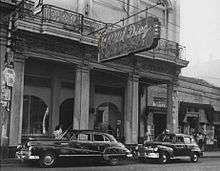Radio Mil Diez
Radio Mil Diez (or Radio 1010) was a radio station broadcasting from Havana, Cuba, owned by the Popular Socialist Party (PSP).[1][2][3] Radio Mil Diez broadcast for five years, between 1943-1948, and played an important role in shaping contemporary Cuban music.
| City | Havana |
|---|---|
| Frequency | 1010 kHz |
| Slogan | La Emisora del Pueblo ('The People's Broadcaster') |
| Programming | |
| Language(s) | Spanish |
| Ownership | |
| Owner | Popular Socialist Party |
| History | |
| First air date | April 1, 1943 |
| Call sign meaning | CMX, COCX |
Emergence
Following the entry of the Soviet Union in the war against Germany the Cuban communists re-emerged as a legal political party, the PSP. The party purchased Radio Lavín and converted it into Radio Mil Diez in 1943.[4][5][6] The first broadcast was made on April 1, 1943.[7] The name reflected the dial sign (1010).[5]
Radio Mil Diez became an important propaganda weapon of the party, and one of the foremost communist media outlets in the Caribbean at the time.[1][8] The slogans of the radio station were La emisora del pueblo ('The Broadcaster of the People') and Todo lo bueno al servicio del pueblo ('All the Best to Serve the People').[7]
Frequency
Radio Mil Diez had the most powerful shortwave radio transmitter in Havana.[3] It broadcast on the frequency 1010 kHz on longwave, with the call sign CMX.[4][9] On shortwave it used a 32-metre band and the callsign COCX.[9] It was the sole international broadcaster in Cuba at the time.[9]
Music

The radio station rarely played prerecorded music, preferring to give opportunities for live bands.[7] It played an important role in developing Cuban Jazz.[10] Radio Mil Diez featured several prominent artists and orchestras, such as Beny Moré's Trío Matamoros, Arcaño y sus Maravillas and Arsenio Rodriguez.[5] Enrique González Mantici directed the orchestra of Radio Mil Diez.[11] Celia Cruz featured as a singer of the Radio Diez Mil orchestra, whilst Mongo Santamaría was part of its rhythm section.[5][11] The radio station sponsored several tours of Cruz, then a young rising singer, across the country.[5]
Adolfo Guzmán was the musical director of Radio Mil Diez.[11] Other musicians that worked at Radio Diez Mil included Elena Burke, Olga Guillot and Bebo Valdés.[5][12]
Through its cultural profile Radio Mil Diez gained a wide audience amongst the black working class.[7]
Truce with Trujillo
Like the PSP party newspaper Hoy Radio Mil Diez voiced vehement criticisms of the rule of dictator Rafael Trujillo in the neighbouring Dominican Republic (the airwaves of Radio Mil Diez reached the Dominican Republic). The anti-Trujillo propaganda from Havana prompted Trujillo to send Ramón Marrero Aristy as his envoy to negotiate with the Cuban PSP. The Cuban PSP agreed to cease the attacks on Trujillo in Radio Mil Diez, in exchange for allowing its Dominican sister party to operate openly. The deal between Trujillo and the Cuban PSP initiated a short period of political liberalization in the Dominican Republic.[1][13]
Closure
In May 1948 Radio Mil Diez was closed down by the Ramón Grau government.[14][15]
Revolution
From January 1959 Radio Mil Diez reappeared and voiced enthusiastic support for the Cuban revolution, whilst remaining close to the PSP party line of reaffirming support for the communist 'old guard' in the labour movement.[16]
References
- Charles. Ameringer (1 November 2010). Caribbean Legion: Patriots, Politicians, Soldiers of Fortune, 1946-1950. Penn State Press. pp. 23–24. ISBN 0-271-04218-4.
- Fabio Rafael Fiallo (2004). Fin de rêve à Saint-Domingue: Aux premières loges de l'histoire dominicaine. Harmattan. p. 101. ISBN 978-2-7475-6743-5.
- Daniel James (1961). Cuba: The First Soviet Satellite in the Americas. Avon Book Division, Hearst Corporation. p. 87.
- Martí Garcia-Ripoll Duran; Cinto Niqui Espinosa (2007). La ràdio en català a l'estranger. Univ. Autònoma de Barcelona. p. 39. ISBN 978-84-490-2499-3.
- Raul A. Fernandez (2006). From Afro-Cuban Rhythms to Latin Jazz. University of California Press. pp. 144–145. ISBN 978-0-520-93944-8.
- Antoni Kapcia (14 October 2005). Havana: The Making of Cuban Culture. Berg. p. 103. ISBN 978-1-85973-837-5.
- David Garcia (7 February 2011). Arsenio Rodríguez and the Transnational Flows of Latin Popular Music. Temple University Press. p. 38. ISBN 978-1-59213-387-1.
- Stefan Baciu (1961). Cortina de hierro sobre Cuba. Ed. San Isidro. p. 26.
- Jorge García Montes; Antonio Alonso Avila (1970). Historia del Partido Comunista de Cuba. Ediciones Universal. p. 304.
- John Shepherd (2005). Continuum Encyclopedia of Popular Music of the World: Caribbean and Latin American. Continuum. p. 41. ISBN 978-0-8264-7436-0.
- Helio Orovio (12 March 2004). Cuban Music from A to Z. Duke University Press. pp. 61, 104–105. ISBN 0-8223-3212-4.
- El Caribe. Cuba pierde al laureado pianista Bebo Valdés
- Lauro Capdevila (1998). La dictature de Trujillo: (République Dominicaine, 1930-1961). Editions L'Harmattan. p. 143. ISBN 978-2-7384-6866-6.
- Ramón Eduardo Ruiz (1972). Cuba: Génesis de una revolución. Editorial Noguer. p. 165.
- John Radanovich (27 September 2009). Wildman of rhythm: the life & music of Benny Moré. University Press of Florida. p. 55. ISBN 978-0-8130-3393-8.
- Efrén Córdova (1987). Castro and the Cuban Labor Movement: Statecraft and Society in a Revolutionary Period (1959-1961). University Press of America. p. 93. ISBN 978-0-8191-5952-6.